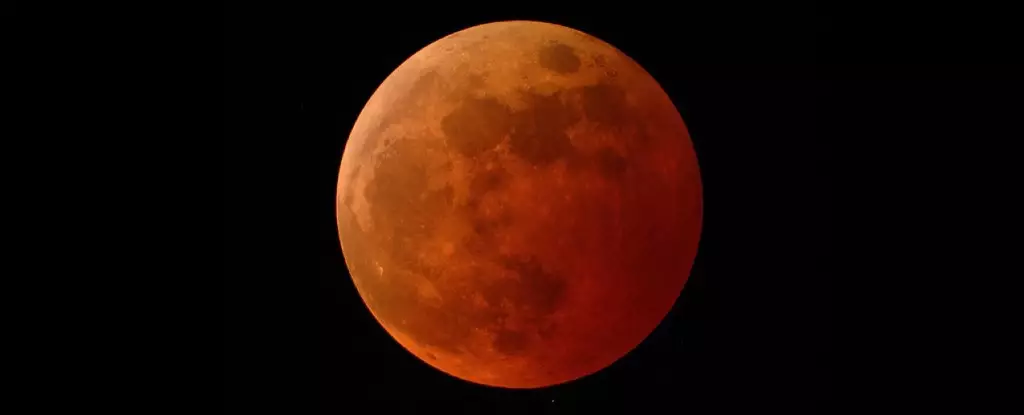In a breathtaking display of astronomical artistry, a total lunar eclipse dubbed the “Blood Worm Moon” will illuminate the night sky for millions across the globe. This rare event, occurring overnight Thursday, invites skywatchers from the Americas to parts of Europe and Africa to witness a stunning visual transformation. To understand the significance of this event, we must first grasp the mechanics behind the magic—a celestial dance of the Sun, Earth, and Moon that unfolds into a remarkable spectacle, providing both scientists and enthusiasts an opportunity to gaze into the depths of our solar system.
The Blood Worm Moon occurs when the Earth positions itself between the Sun and the Moon. This alignment allows Earth to cast a substantial shadow that engulfs the Moon, initiating a process that showcases nature at its finest. Instead of disappearing entirely into darkness, however, the moonlight adopts a warm red hue—an enchanting characteristic resulting from sunlight being refracted—bent and scattered—through Earth’s atmosphere, much like the vibrant colors that paint our skies at dawn and dusk. According to astronomer Daniel Brown from Nottingham Trent University, this phenomenon is an awe-inspiring reminder of the compelling forces at play within our universe.
The Essence of Color in Shadows
The fascinating transformation of the Moon during this eclipse is not merely a scientific curiosity; it resonates on an emotional level as well. The crimson glow evokes feelings of wonder and introspection, reminiscent of the diverse cultural interpretations surrounding such celestial events throughout history. While the term “Blood Moon” may invoke negative connotations for some, particularly for Brown—who expresses discomfort with its origins in apocalyptic lore—it also provides a platform for dialogue about our relationship with nature.
Different cultures have heralded lunar eclipses as significant omens or opportunities for reconciliation. For instance, African traditions perceive a lunar eclipse as a symbolic conflict between the Sun and Moon, encouraging communities to set aside differences in favor of unity. During such an extraordinary moment, amid the gathering shadows, people are prompted to reflect on their interpersonal bonds—an inspiring narrative that could not come at a more opportune time, as modern societies seek connection in an increasingly fragmented world.
The Time and Place for Celebration
Eclipses are fleeting, ephemeral events reminding us of the cyclical nature of time and existence. This upcoming lunar eclipse, which will last approximately six hours, will see the period of totality last for just over an hour—a significant duration to engage with the cosmos. In North America, the bemusing progression starts at 1:09 am Eastern Time, leading into the crimson peak between 2:26 am and 3:31 am. Meanwhile, in France, observers can anticipate totality between 7:26 am and 8:31 am, though only specific regions will get the full experience.
The early hours of the morning and the cloudy forecasts may deter some observers, but for the dedicated stargazers, this eclipse is a chance to mingle with the mysteries of the universe. The unfortunate reality of some geographical limitations means that while New Zealand may see only a partial view as the Moon rises, the opportunity remains for those in the right locales to indulge in astronomical brilliance.
Anticipating the Future
The 2023 Blood Worm Moon marks the first total lunar eclipse since 2022, but it is not the last. Another chance to witness this cosmic serenade will emerge later in September. The peculiarities of this event, classified as a “Micromoon,” emphasizes the Moon’s distance from Earth, which diminishes its appearance by about seven percent—an intriguing contrast to the recent Supermoon surprise of the previous year.
As a tantalizing added treat, skygazers can look forward to a partial solar eclipse on March 29, enabling some regions to experience a celestial blocking of the Sun’s rays. However, a vital reminder prevails: safety is paramount, and anyone keen on viewing this dazzling display should equip themselves with eclipse glasses or inventive pinhole projectors, as the allure of a solar eclipse should never come at the cost of one’s eyesight.
In celebrating the enchanting experience of the Blood Worm Moon, we are beckoned not only to marvel at its beauty but also to embrace the spirit of community it fosters. With every eclipse or celestial event, we are invited to shift our focus to perspectives that unite us, transcending borders for a shared appreciation of the vast universe we inhabit.

